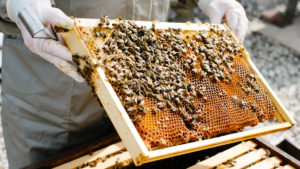Belararox says grade is king at Belara base metals project

The company plans to announce the initial resource estimate for Belara in September.
Belararox says its intersected Volcanogenic Massive Sulphide (VMS) mineralisation in multiple drill holes that are of higher grade for copper, gold and zinc than historical modelling at its Belara project in NSW.
Volcanogenic Massive Sulphide (VMS) deposits are one of the richest sources of metals such as copper, lead, and zinc globally, and can also produce economic amounts of gold and silver as by-products.
Historical mining at Belara reported average mining grades of up to 3-5% copper, 2-4.5 g/t gold, and 2-3 oz silver.
And, Belararox’s (ASX:BRX) more recent drilling has returned results of:
- 7m at 2.22% zinc, 2.54% copper, 0.63% lead, 36.87 g/t silver and 0.67 g/t gold from 78m, including 3m at 4.73% zinc, 5.85% copper, 1.30% lead, 82.60 g/t silver and 1.5 g/t gold (BLRC013); and
- 17m at 0.94% zinc, 0.52% copper, 0.27% lead, 10.79 g/t silver and 0.21 g/t gold, from 81m, including 3m at 3.84% zinc, 1.15% copper, 1.10% lead, 43.87 g/t silver and 0.77 g/t gold from 81m (BLRC011).
The next step is a maiden resource
The company says mineralisation in BLRC011 provides additional confidence that the new exploration targets defined using geophysical data may host similar mineralisation to the Belara mine area.
Plus, hole BLRC013 is along strike and at the same depth from high-grade zinc, copper, lead, silver and gold mineralisation reported in BLRC011 – NS confirms high grade mineralisation closer to the surface over a 150m strike.
The company says its on track to deliver a maiden resource estimate over the historic mines at Belara and Native Bee in September.

Location of the Belara Project tenements with respect to the regional geology over the prospective trend for volcanic-associated massive sulphide mineralisation, which hosts the Belara and Native Bee historic mines. Image: Suppled.
Extension drilling planned
In October, Belararox is aiming to kick off extension drilling based on prospective modelling – and look to delineate an expanded resource estimate based on the extension drilling.
And since the project covers a hefty 643km2, EM and FLEM surveys will be expanded to cover the entire tenure.
The company will also kick off a reconnaissance field program of 6 holes for 1,500m to test high priority targets – followed by infill drilling of prospective Belara and Native Bee extensions.
High priority targets at Bullabulling
At the company’s Bullabulling Project in WA, 3D prospectivity modelling using machine learning techniques has mapped 7 high priority targets for exploration.
The targets have similar geophysical, geological and geochemical characteristics as the nearby 3Moz Bullabulling and 320Koz Geko gold mines and are 1,400m x 400m and extend 250m down the dip of the contact.
RC drilling is planned in October.
This article was developed in collaboration with Belararox Limited, a Stockhead advertiser at the time of publishing.
This article does not constitute financial product advice. You should consider obtaining independent advice before making any financial decisions.
Related Topics
UNLOCK INSIGHTS
Discover the untold stories of emerging ASX stocks.
Daily news and expert analysis, it's free to subscribe.
By proceeding, you confirm you understand that we handle personal information in accordance with our Privacy Policy.








